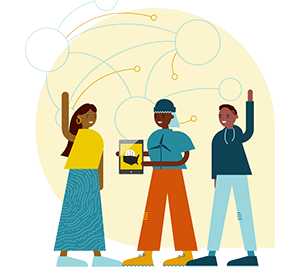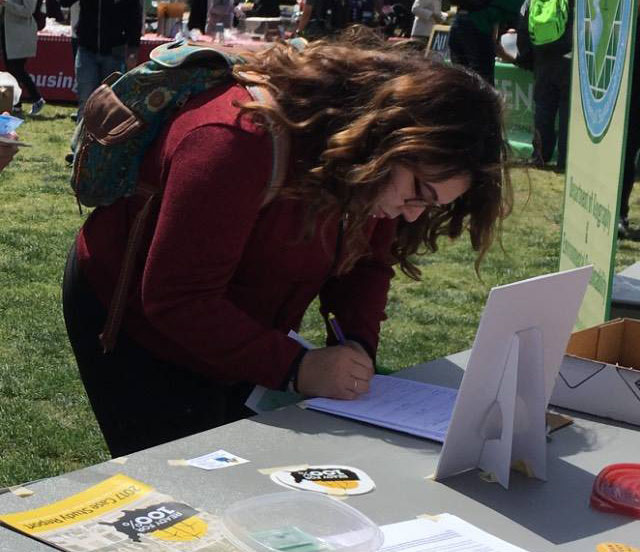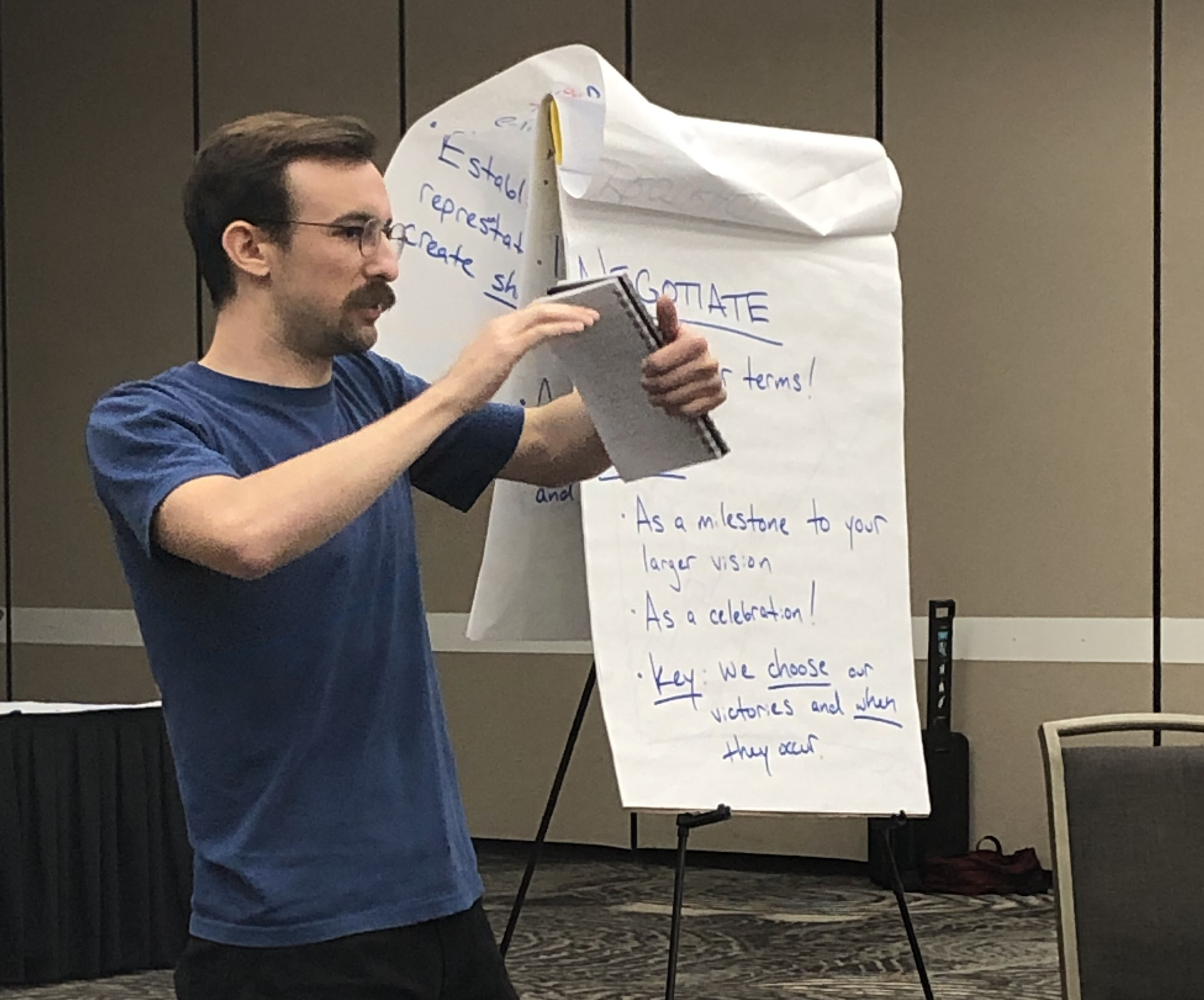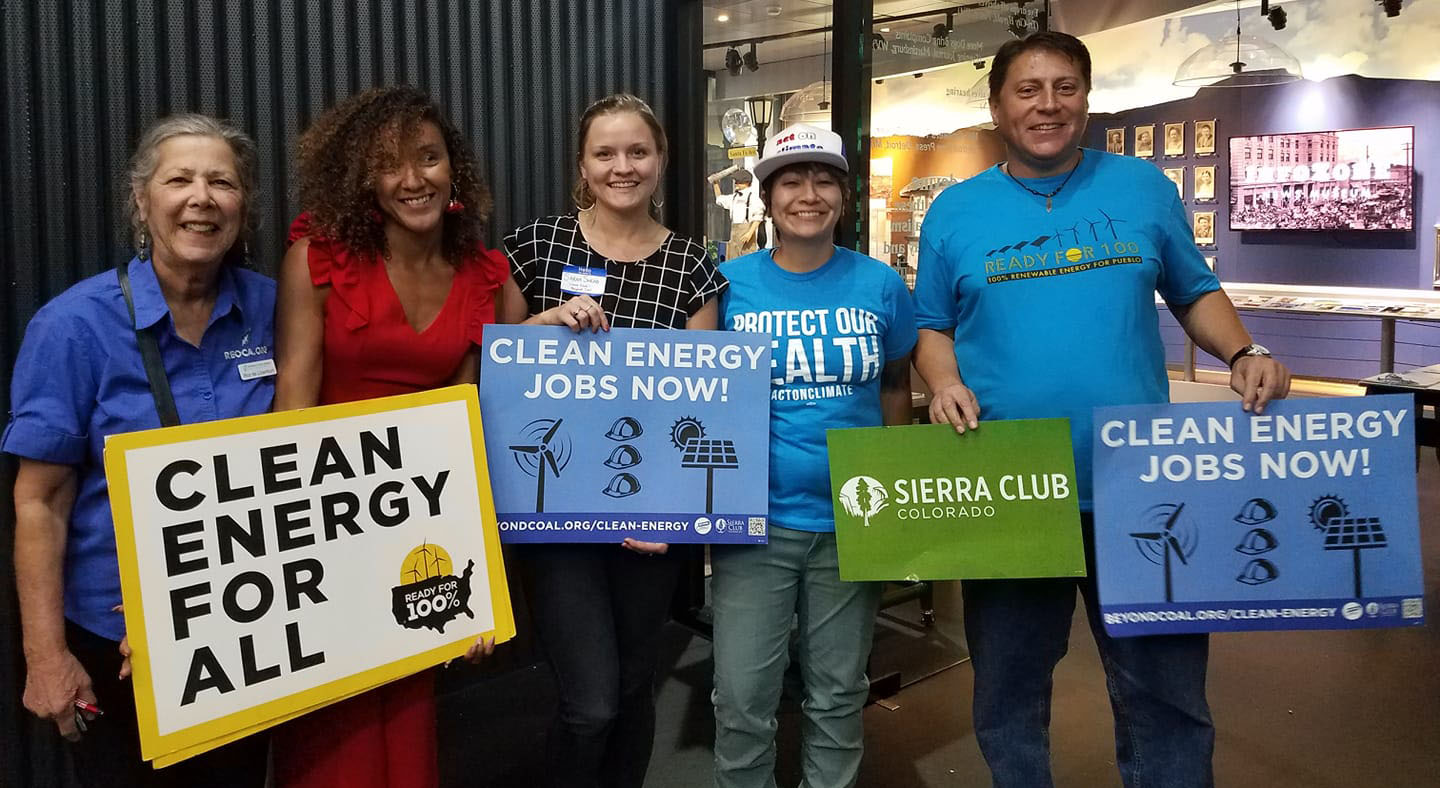Build a Team

- Build a Team
-
Phase 3
Plan Your Strategy
-
Phase 4
Public Launch
-
Phase 5
Organize!
-
Phase 6
Implementation and Beyond
-
Contact Us
Get help, give feedback, or share resources
Recruit
Now that you better understand your community, its history, and its relationship with energy, it is time to recruit an initial core group of volunteer community members specific to this campaign. Recruitment is how we build our resources: human energy, experience, skill, creativity, passion and hope. Eventually you will build recruitment into everything you do—every meeting, action, event, and conversation is an opportunity to recruit. Effective recruitment requires a vision of what you want to build, a strategy for how you will grow your team, tactics to bring new people in, and people to do the work!
You only need a handful of people to get started—and there's no wrong way to get started. Some campaigns have gotten started by contacting their local Sierra Club chapter or group while others have organically formed from one person contacting their friends, families or neighbors, and still others found their people by doing online and offline recruitment tactics. Making a flyer and posting it at local coffee shops and community boards or contacting other local nonprofits and asking them to share your campaign and contact info on their listservs would be “offline recruitment” tactics. If you want to use the internet to do outreach, that’s what we call “online recruitment tactics,” and may include posting to social media or sending emails.
Recruit & Organizing Online
The Online Organizing guide will help you learn more about tools for online recruitment and organizing, including how to create emails.
Find a team and get started
-
Ensure diversity of team members. Of course, building a team that is representative of your community is important. By building a diverse team that includes members of other organizations, from neighborhoods across your community and of different identities, you honor our movement’s values of fairness, equality, and opportunity. This likely also includes recruiting members who bridge age, culture, or language differences.
-
Be inclusive! Make accommodations to help everyone feel welcome. Find ways to accommodate participation and access. Consider childcare needs, health issues, transportation, and work schedules when creating opportunities for people to get involved. Bonus— you’ll tap into the competitive advantages of diverse teams: innovation, productivity, efficiency, and problem solving.
-
Plan your initial team meeting. Plan your first team meeting, where you can share why transitioning to 100% clean renewable energy matters to you and what solutions it will bring to your community for equity, justice and the environment, sharing the campaign factsheet. Invite friends, family, coworkers, neighbors, allies, and interviewees from Phase 1.
At this meeting, explain that you’re interested in working with them to build a core team and develop a plan to move the community to 100% clean and renewable energy, and individually explain how their voice would be important to this work and why you want them as part of your core team. Need help planning the meeting? Check out Seeds for Change's guide for meetings. -
With any new person who shows up to your meeting, schedule an individual meeting with them. This is commonly called a “one-on-one”. A one-on-one is a conversation to build a relationship for action around shared self-interest. It is a natural way to get to know someone better and understand their values, vision, life and motivations. Learning people’s motivations and sharing your own ensures that you understand people more fully, and campaign leaders can develop roles that best match their skills and interests.

Tabling at college involvement fair in Norman, OK. | Photo by Adrienne Gautier.
While it is important to transition to clean energy quickly, what is equally or even more important is how we make that transition and who is involved in that process. Our current energy systems are not only responsible for climate change, but also for prioritizing some communities and people over others in terms of access, decision making, economic costs, jobs, and pollution. We are advocating for a just transition to renewable energy that helps to democratize our energy system, decentralize our energy infrastructure, improve grid reliability, and equitably distribute the economic costs and benefits of owning and generating energy. We need to make sure our groups are an example of the change we want to see.
Building your power and growing your base for this campaign must involve reaching out to new and diverse people and groups.
Roles and Responsibilities
The next step after recruiting your core team is to convene another meeting to figure out how you will work together and how to divide roles and responsibilities among your group. Consider your role as an initiator of the group. What power do you have? What privilege do you bring? What biases? Everyone (including you!) should have a roughly equal share based on the unique skills and resources they bring to the team, understanding that each part is necessary to adequately develop your campaign plan and reach an ultimate goal.
One way to organize your team is to build roles that reflect our national team structure:
-
Someone who likes to communicate to the world about what your campaign is doing and is willing to serve as a spokesperson (Communications)
-
Someone who is good at using tech tools to get the word out and engage people in taking action (Digital Organizing)
-
Someone who is good at outreach and getting new folks involved in the campaign (Grassroots Organizing)
-
Someone who is excited about the technical or policy aspects of the energy transition and can talk about this in advocacy meetings (Policy)
Of course there are many other roles you might consider including, depending on the interests and strengths of the individuals in your group: Volunteer Coordinator, Partners/Coalition Coordinator, Business Coordinator, or Arts Coordinator, to name a few. There are also roles for those people who like to facilitate team meetings or care deeply about equity and are interested in integrating that element of work into everything the team does.
Roles and support resources
The benefit of setting up the roles on your team in this way is that each of those roles would have a point person for support from Sierra Club’s national network. Check out the overview and draft role descriptions along with information about how to get connected to the networks. The goal is to put members of your team in direct contact and coordination with others doing similar work elsewhere so everyone has the training, support and materials they need to be successful and to help inform and strengthen the national campaign.
Think about these as a space for folks doing similar work to connect to answer each other's questions, give support, and learn from each other. Your campaign team will build, change and develop over time. You can recruit leaders to fill the capacities your campaign needs and also create roles that meet the skills and motivations of your leaders.
Once team structure, roles and responsibilities have been agreed upon, delegate the roles to those in the core group. Determine how the team wants to work together by answering some of these questions:
-
What are the expectations for accountability?
-
What decisions can the team members make on their own?
-
How are other decisions made? What decisions must the team consult about? This guide to decision-making structures can help.
-
How will we communicate: Slack, email, phone calls, text? How often? Teams should aim to be in contact monthly at a minimum.
-
How often should we meet? For how long?
In answering these questions, your team begins the process of developing group agreements or norms. Being clear about how your team operates will make it easier to welcome and orient new people so they can participate fully and comfortably.
Training

Training is an integral part of any campaign. At its core, training is teaching—a way to pass along skills and knowledge, develop leaders, and share the work more equitably within the team. Trainings are also an important space to build deep relationships with one another, learn new skills and ways of being in the world, unlearn the stuff that is getting in our way, and feel inspired for further action. Trainings can even be a great way to recruit new people to your campaign, as they provide a time and place to connect, build shared understanding of the challenges the campaign is facing, and move the members of your campaign up a ladder of engagement.
Additionally, once your campaign plan is complete and your team is assembled, your new contacts with the Sierra Club can steer you toward more capacity-building opportunities, such as workshops through the Chapter Support Team, or dialogues with our Department of Equity, Inclusion, and Justice.
Partnerships and alliances: Ensure equity and justice at all stages

Coalition leaders in Pueblo, CO, presenting a screening of the documentary, Reinventing Power. | Photo by Jamie Valdez.
Organizations that historically have represented a White, relatively wealthy constituency, including the Sierra Club, need to be aware of our inherent power and privilege when entering into conversations and partnerships with communities of color and low-income communities. Even well-intentioned offers to canvass a neighborhood, table at an event, or pay for a promotional piece can undermine a partner organization or distract from their community’s voice. We should not assume that our involvement or engagement is welcome right off the bat; building a relationship and earning trust is a slow process.
It is important to know that working with a privileged group like the Sierra Club comes with a responsibility to understand how the organization’s power and privilege provide it outsized access and influence among decision makers, often with the effect of diminishing the role(s) of partners. Discussing and working through these topics can help avoid alienating critical allies, and help the campaign and organization use its privilege to amplify the voices of those who have been shut out of decision-making in the past.
Learn the key elements to organizing in an inclusive way!
-
Train your team with our Jemez Principles training module
A successful partnership and collaboration that builds a broader and more effective movement is one in which those with more power use their resources to intentionally raise the voices, influence, and power of their less privileged partners. This is particularly important with regard to the impacts of transitioning to clean and renewable energy on those partners and the groups they work with or represent. Think, for example, of renters on a fixed-income. They might be less able to afford or benefit from a residential-solar program that the privileged organization would like to see put in place. If not done in collaboration (or, at minimum, consultation), that solar program could increase home values and property taxes, and result in displacing low-income community members.
In developing relationships with potential partner organizations, start first with one-on-one meetings, listen to community leaders talk about the issues important to them, and build authentic connections. Look back at your clean energy interviews and do more research to meet with those in organizations that are currently impacted by the current energy systems, disproportionately impacted by climate change, or working on similar issues. Real relationships with partners and allies take time to grow and develop. When all of this is done well, the campaign team will have the allies sitting at the table, helping to create the plan. For more information, review Sierra Club’s Partnership Principles.
Rather than establishing goals and strategies, and then asking prospective allies to come along, partners and allies need to be equal partners in creating those goals and strategies. Partner organizations should be seen as key members to your core team, not outside organizations you “sometimes work with.”
Consider when and how to engage decision-makers. Depending on your goal, they might be your target, a team member, or a partner you consult!
Try to answer these questions before moving on.
False! It’s important to build a team that is representative of your entire community. This means including people outside your circle and of various demographics to ensure the team reflects the campaign’s values of fairness, equality, and opportunity.
The answer is B. Always reach out to new meeting attendees and request a one-on-one to get to know them and understand their values, vision, life and motivations.
False! Partners and allies need to be equal partners in creating goals and strategies.